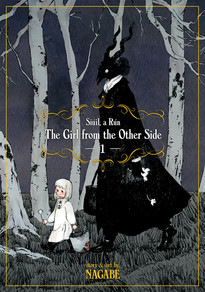Review
by Rebecca Silverman,The Girl From the Other Side: Siúil, a Rún
GN 1
| Synopsis: |  |
||
A long time ago in a Celtic land, stories were told to children about being wary of those from “The Outside.” If an Outsider, those who are not entirely human, should touch you, you will be cursed to become just like them. But what if you rely on an Outsider to take care of you? Little girl Shiva has somehow come to be the only human in her part of the woods, and an Outsider has taken it upon himself to be her guardian. Is it possible for human and Outsider to coexist? Or is this tale doomed to an unhappy ending? |
|||
| Review: | |||
Folklore is full of warnings for the careless: don't dance in the fairies' circle, eat no food in the underworld or fairy realms, don't listen to the siren's or rusalka's song – the list goes on. In the world of Nagabe's strange and haunting The Girl from the Other Side: Siúil, a Rún, the main directive is not to have physical contact with “Outsiders,” not-quite-human beings whose touch can curse those who ignore this advice. Young Shiva remembers hearing this from her aunt when she lived with her, but now she finds herself in a strange situation: her aunt having vanished, Shiva is under the care of an Outsider. It's clear almost from the start of the manga that Nagabe is mixing a few mythologies. Shiva's name comes from either Hinduism (where it refers to a god) or Judaism (where it refers to a mourning ritual), and the Outsiders all have a slight look of devils from Christian iconography. The tale itself and its setting, however, give off much more of a Celtic feel, which is backed up by the manga's subtitle, Siúil a Rún, the name of an Irish folksong. (Some may be familiar with its American variant “Johnny's Gone for a Soldier.”) Soldiers wear chainmail and the Outsiders dress like mid 18th century gentlemen, with Shiva in a smock that could belong to any time or place. It's a time-out-of-time set up that really works to establish the mood of the piece, which is perhaps best described as not quite real. The characters inhabit a shadowland where the line between folktale and reality blurs, making neither seem possible, and therefore all things probable. This mood is deftly enhanced by Nagabe's use of grey space. Although there is a fair amount of both black and white in the artwork, the overall feeling that somehow it is drawn entirely in shades of grey comes from both the unreality of the story and the dark feeling of the art. A lot of panels are done primarily in black with thin white outlines of windows, grass, or Shiva's hair and dress, and sections done against white backgrounds have only the thinnest of white lines to denote the characters and background. All of this contributes to giving the story the feel of taking place in a largely abandoned world, something which is driven home when the Outsider and Shiva venture to a village in search of food for the little girl – the food is still edible, which certainly says something about how long the two have been alone in the forest. Apart from the use of black and white spaces, the art is a little unsettling. Shiva is the only person drawn with a face, and even then, it's only the bare minimum needed to give us a sense of her expressions. Body language is much more indicative of character mood, which is important since the Outsider lacks a human face, instead having a head that is something like a cross between a bird and a goat. His human (seeming) body tells us how he's reacting, and it's very clear that he loves Shiva like his own child, especially as he reveals to readers what her story really is. That story is wrapped up in ideas of an Inside and an Outside, which smacks of both dystopian fiction and folklore about the underworld. In Celtic tales, Irish specifically, it is referred to as “the Other Side” rather than “Outside,” but the Outsiders themselves do seem to have a bit in common with the slua, spirits of the restless dead, and some stories have them carrying off the dying. That makes the Outsider who cares for Shiva particularly interesting, as he would be doing the opposite of the slua in keeping the girl alive. At this point, TThe Girl from the Other Side: Siúil, a Rún is running on pure atmosphere and a lot of folkloric questions. Part Irish myth, part medieval narrative of fear, the story moves slowly, enchanting readers with its simplicity, but risking frustrating them with it as well. It is undeniably intriguing, and certainly stands to appeal to fans of The Ancient Magus' Bride, but it also isn't for readers who like their stories to move quickly. If you enjoy stopping in the shadowy wood of an evening, however, and listening to old tales about the Others, this is something you should give a chance to pull you into its twilit world. |
| Grade: | |||
|
Overall : B
Story : B
Art : B+
+ Fascinating use of Irish mythology in the story and monochrome in the artwork, story poses some interesting questions |
|||
| discuss this in the forum (2 posts) | | |||
| Production Info: | ||
|
Full encyclopedia details about Release information about |
||